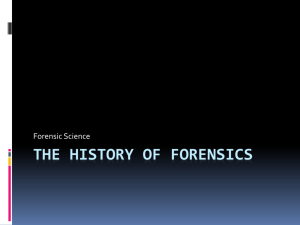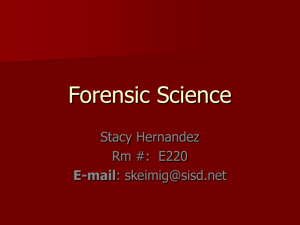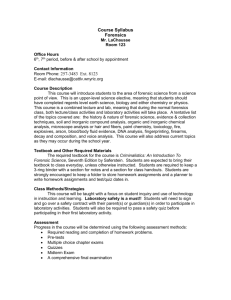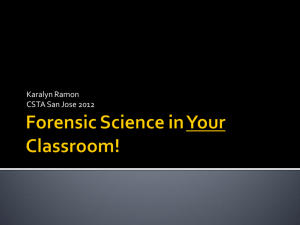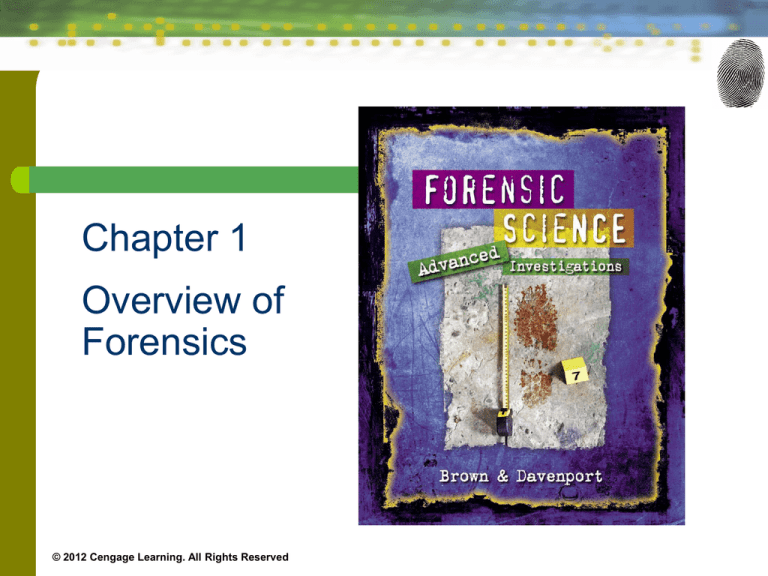
Chapter 1
Overview of
Forensics
© 2012 Cengage Learning. All Rights Reserved
Introduction—Objectives
1. Define forensic science.
2. Describe the significance of the key
contributors to the field of forensics.
3. Explain how forensic science relies on
multiple disciplines to solve crimes.
4. Describe how the scientific method is used
to solve forensic science problems.
5. Describe the search methods used to
search a crime scene.
2
Forensic Science II: Overview of Forensics, Chapter 1
© 2012 Cengage Learning. All Rights Reserved
Introduction—Objectives
6. Describe proper techniques for collection
and packaging of physical evidence.
7. Distinguish between class and individual
evidence.
8. Discuss the importance of significant cases
that have impacted forensic science.
9. Outline the steps of the judicial process
from identification of a suspect through the
trial.
3
Forensic Science II: Overview of Forensics, Chapter 1
© 2012 Cengage Learning. All Rights Reserved
Introduction—Vocabulary
o
o
o
o
4
chain of custody - a list of all people who came into
contact with an item of evidence
class characteristics - properties of evidence that
can be associated only with a group and never a
single source
Frye Standard - rule of admissibility of evidence;
evidence, procedures, and equipment presented at
trial must be generally accepted by the relevant
scientific community
individual characteristics - properties of evidence
that can be attributed to a common source with an
extremely high degree of certainty
Forensic Science II: Overview of Forensics, Chapter 1
© 2012 Cengage Learning. All Rights Reserved
Introduction—Vocabulary
o
o
o
o
5
Locard’s exchange principle - when two objects
come into contact with one another, a cross-transfer
of materials occurs
physical evidence - any object that can establish
that a crime has been committed or can link a
suspect to a victim or crime scene
reference sample - a sample from a known source
used for comparison, also referred to as exemplar
scientific method - a series of logical steps to
ensure careful and systematic collection,
identification, organization, and analysis of
information
Forensic Science II: Overview of Forensics, Chapter 1
© 2012 Cengage Learning. All Rights Reserved
Murders at the Mansion
o
o
o
o
o
o
o
6
The Menendez brothers - Lyle (21) and Erik (18)
August 20 1989 — the brothers’ story is that they
went out for the evening
The brothers call 911 at 11:47 to report the murder
of their parents
After paying debts, there’s a $2 million estate
By end of year, the brothers spent half of the estate
Arrested in March 1990; indicted on Dec 8, 1992
Defense admits brothers killed their parents, but
claims sexual, physical, and emotional abuse
Forensic Science II: Overview of Forensics, Chapter 1
Forensic
Science Learning.
II: Title, Chapter
# Reserved
© 2012 Cengage
All Rights
Historical Development (Obj 1.2)
o
o
o
o
7
Alphonse Bertillon (1853–1914) — developed the
first method of criminal identification
Sir Edward Richard Henry (1850–1931) —
developed a fingerprint identification system that
categorized fingerprints by whorl, loop, or arch
pattern
Karl Landsteiner (1868–1943 — discovered blood
groups
Edmond Locard (1877–1966) — founder of the
Institute of Criminalistics at the University of Lyon in
Lyon, France
Forensic Science II: Overview of Forensics, Chapter 1
© 2012 Cengage Learning. All Rights Reserved
Historical Development (Obj 1.2)
o
o
o
o
8
Calvin Goddard (1891–1955) — invented the
comparison microscope
Rosalind Franklin (1920–1958) — studied the
molecule’s structure using X-ray diffraction
photography of DNA
James Watson (1928– ) and Francis Crick (1916–
2004) — using Franklin’s photography, constructed
a structural model of DNA
Alec Jeffreys (1950– ) — invented DNA
fingerprinting
Forensic Science II: Overview of Forensics, Chapter 1
© 2012 Cengage Learning. All Rights Reserved
A Multidisciplinary Approach (Obj 1.3)
Examples:
Forensic nurse
Forensic chemist
Forensic toxicologist
Forensic meteorologist
Forensic accountant
9
Forensic Science II: Overview of Forensics, Chapter 1
© 2012 Cengage Learning. All Rights Reserved
The Scientific Method (Obj 1.4)
10
Forensic Science II: Overview of Forensics, Chapter 1
© 2012 Cengage Learning. All Rights Reserved
The CSI Team and Crime Labs
(Obj 1.5, 1.6, 1.7)
The crime-scene investigation team is a team
of legal and scientific experts who work
together to process a crime scene and
evaluate the evidence
11
Forensic Science II: Overview of Forensics, Chapter 1
© 2012 Cengage Learning. All Rights Reserved
The CSI Team and Crime Labs
(Obj 1.5, 1.6, 1.7)
12
Forensic Science II: Overview of Forensics, Chapter 1
© 2012 Cengage Learning. All Rights Reserved
The CSI Team and Crime Labs
(Obj 1.5, 1.6, 1.7)
Processing a Crime Scene
Investigators choose the search method based on the size and
location of the crime scene
Zone: building or other structure—homicide, home
invasion, robbery, sexual assault, etc.
Spiral: large area, no barriers—open field—
kidnapping, homicide
Line search: large area looking for a large object in
a single direction—site of a plane crash
Grid: large area looking for a large object in two
directions—arson investigation
13
Forensic Science II: Overview of Forensics, Chapter 1
© 2012 Cengage Learning. All Rights Reserved
The CSI Team and Crime Labs
(Obj 1.5, 1.6, 1.7)
o
o
o
14
Testimonial evidence — the witness
testimony used to build a timeline of events
Physical evidence —any material collected
or observed at a crime scene that could link
potential suspects to a crime
What is Chain of Custody?
Forensic Science II: Overview of Forensics, Chapter 1
© 2012 Cengage Learning. All Rights Reserved
Evidence
o
Chain of Custody
•
•
•
15
Provides documentation of every person who has
come into contact with the evidence
A paper trail
Demonstrates to the courts that the evidence that
is being presented at trial is free of contamination,
alteration, or substitution
Forensic Science II: Overview of Forensics, Chapter 1
© 2012 Cengage Learning. All Rights Reserved
Evidence
o
o
o
o
16
Trace Evidence
Reference samples
Class characteristics
Individual characteristics
Forensic Science II: Overview of Forensics, Chapter 1
© 2012 Cengage Learning. All Rights Reserved
Evidence
17
Forensic Science II: Overview of Forensics, Chapter 1
© 2012 Cengage Learning. All Rights Reserved
Landmark Cases (Obj 1.8)
Frye v. United States (1923)
The Frye Standard — evidence, procedures,
and equipment presented at trial must be
generally accepted by the scientific
community
18
Forensic Science II: Overview of Forensics, Chapter 1
© 2012 Cengage Learning. All Rights Reserved
Landmark Cases (Obj 1.8)
Daubert v Merrell Dow Pharmaceuticals (1993)
U.S. Supreme Court ruled that the trial judge
had ultimate decision-making power
regarding expert testimony at trial
1. Has it been tested?
2. Has it been peer reviewed?
3. What is the rate of error?
4. Is it generally accepted?
19
Forensic Science II: Overview of Forensics, Chapter 1
© 2012 Cengage Learning. All Rights Reserved
Landmark Cases (Obj 1.8)
20
Forensic Science II: Overview of Forensics, Chapter 1
© 2012 Cengage Learning. All Rights Reserved
Landmark Cases (Obj 1.8)
Dr. Carl Coppolino (1963)
o The court ruled
•
•
21
The fact that a technique, test, or procedure is
new does not necessarily mean its findings are
inadmissible in court
The expert witness is responsible for providing
scientifically valid testimony to support the
findings
Forensic Science II: Overview of Forensics, Chapter 1
© 2012 Cengage Learning. All Rights Reserved
The Judicial Process (Obj 1.9)
o
o
The U.S. Constitution (1787)
The Bill of Rights (1789)
•
•
22
The first ten amendments to the constitution
Sixth amendment ensures that a person will be
tried by an impartial jury of his or her peers
Forensic Science II: Overview of Forensics, Chapter 1
© 2012 Cengage Learning. All Rights Reserved
The Judicial Process (Obj 1.9)
o
Arrest - gathering evidence to show probable
cause
•
•
•
•
o
o
23
Observation
Expertise
Information
Circumstantial evidence
Before the Trial — the discovery phase
At the Trial — prosecution and defense
present their cases
Forensic Science II: Overview of Forensics, Chapter 1
© 2012 Cengage Learning. All Rights Reserved
24
Forensic Science II: Overview of Forensics, Chapter 1
© 2012 Cengage Learning. All Rights Reserved
Chapter Summary
o
o
o
o
25
Forensic science is the application of science to law.
Many disciplines are utilized in forensic science.
Processing a crime scene requires a thorough and
systematic approach.
Physical evidence is any substance that can link a
potential suspect to a victim or crime
Forensic Science II: Overview of Forensics, Chapter 1
© 2012 Cengage Learning. All Rights Reserved
Chapter Summary
o
o
o
26
When processing evidence, investigators use
identification and comparison tests to attempt to
make connections between victims, suspects, and
crime scenes.
Evidence that possesses class characteristics can
be associated with a group rather than with a
specific individual.
Evidence that possesses individual characteristics
can be associated with a single person with a high
degree of certainty.
Forensic Science II: Overview of Forensics, Chapter 1
© 2012 Cengage Learning. All Rights Reserved
Chapter Summary
o
o
o
o
27
A chain of custody is necessary to maintain the
integrity of the evidence.
The judicial process in the United States is based on
the U.S. Constitution.
Law enforcement personnel must prove probable
cause before a judge will sign a search or arrest
warrant.
In court, a jury of the suspect’s peers hears evidence
from both sides.
Forensic Science II: Overview of Forensics, Chapter 1
© 2012 Cengage Learning. All Rights Reserved


